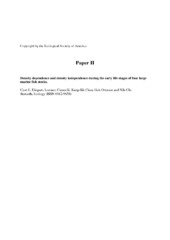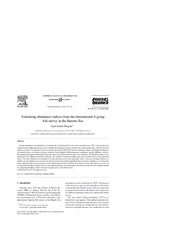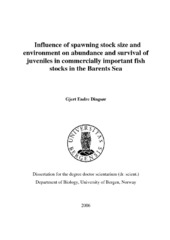| dc.contributor.author | Dingsør, Gjert Endre | eng |
| dc.date.accessioned | 2006-07-07T13:57:20Z | |
| dc.date.available | 2006-07-07T13:57:20Z | |
| dc.date.issued | 2006-05-05 | eng |
| dc.identifier.uri | http://hdl.handle.net/1956/1515 | |
| dc.description.abstract | Stock-recruitment relationships are fundamental in management of fish stocks and fish recruitment is highly variable. Hence, a mechanistic understanding of the factors causing the variability in recruitment is a necessity to be able to predict the development of a harvestable stock. To get continuity in the management it is also important to get an early indication of the size of future year-classes recruiting to the fisheries. Survey-based abundance indices are often used to assess the state of a fish stock and to predict the strength of future year-classes, it is therefore important that these estimates give a correct picture of the present state of the stock. However, both biotic and climatic factors are known to affect year-class strengths and these factors can exhibit nonlinearities and non-additive properties that are difficult to incorporate in traditional stock-recruitment models. My thesis consists of three papers focusing on I) estimation of abundance indices of 0-group fish in the Barents Sea, II) biotic and climatic effects on 0-group and age-1 abundances of capelin (Mallotus villosus), northeast Arctic cod (Gadus morhua), northeast Arctic haddock (Melanogrammus aeglefinus), and Norwegian spring spawning herring (Clupea harengus), and III) spatial variability in survival of 0-group northeast Arctic cod. Survey data of 0-group fish in the Barents Sea are reviewed back to 1980, new abundance indices are estimated, and different methods for estimating abundance indices are evaluated. The new methods used to calculate the indices retain more of the dynamics in the annual recruitment than the previous methods do. The Pennington estimator method is concluded to be the preferable method for estimating 0-group indices for the Barents Sea. It is also attempted to correct for lengthdependent selection properties of the trawl and it is shown that this bias affects both length and abundance estimates. However, it is concluded that more research is needed to quantify this bias under different environmental conditions before it is advisable to correct for it in the abundance indices. Generalized additive modeling (GAM) and threshold GAM (TGAM) are applied in modeling the effect of biotic and climatic effects on the abundances at the 0-group and age-1 stages of capelin, northeast Arctic cod, northeast Arctic haddock, and Norwegian spring spawning herring in the Barents Sea. Spawning stock biomass, temperature, and density-dependent mechanisms are important factors affecting the year-class strengths of 0-group fish in the Barents Sea. The mean age of the cod spawning stock affects the abundance of 0-group cod, highlighting the importance of maintaining a diverse age-structure in the spawning stock. Cod, haddock, and herring have a similar response to temperature, which is possibly a proxy for available zooplankton. The results indicate that when strong year-classes are formed, the competition for food increases both within and between species. It is demonstrated that the intensity of density dependence can change over temporally distinct environmental phases. Density-independent factors may thus indirectly affect population dynamics through changes in density-dependent regulation. The complexity of interactions between biotic and climatic variables is difficult to incorporate in traditional stock-recruitment models. In such a context, the phasedependent and nonparametric methodology of threshold generalized additive models has advanced our ability to address internal and external mechanisms in recruitment dynamics. The abundances at age-1 are well correlated with 0-group abundances, indicating that year-class strengths at age-1 are determined prior to the 0-group survey in August- September. Predation by cod and temperature also affect age-1 abundances, and especially cod predation may affect the year-class strengths before they recruit to the fisheries, but in general strong year-classes will remain strong and poor will remain poor. The climatic conditions and the density of predators show high spatial variability in the Barents Sea and it is thus plausible that the survival of 0-group fish also shows high spatial variability. With northeast Arctic cod as a case study, the spatial variability in survival is modeled using GAM and TGAM. The spatial pattern of 0- group cod survival is primarily affected by top-down mechanisms and by predationdriven density dependence. Climate-related variables can strongly influence the spatial survival pattern of 0-group cod by affecting their distribution and the overlap with predators. | en_US |
| dc.format.extent | 3577003 bytes | eng |
| dc.format.extent | 342155 bytes | eng |
| dc.format.extent | 378087 bytes | eng |
| dc.format.extent | 2805755 bytes | eng |
| dc.format.mimetype | application/pdf | eng |
| dc.format.mimetype | application/pdf | eng |
| dc.format.mimetype | application/pdf | eng |
| dc.format.mimetype | application/pdf | eng |
| dc.language.iso | eng | eng |
| dc.publisher | The University of Bergen | en_US |
| dc.relation.haspart | Paper I: Estimating abundance indices from the international 0-group fish survey in the Barents Sea. Gjert Endre Dingsør. Fisheries Research, 72 pp. 205-218, Copyright (2005) Elsevier.<a href”http://dx.doi.org/10.1016/j.fishres.2004.11.001”target=_”blank”> http://dx.doi.org/10.1016/j.fishres.2004.11.001</a> | en_US |
| dc.relation.haspart | Paper II: Density dependence and density independence during the early life stages of four largemarine fish stocks.Gjert E. Dingsør, Lorenzo Ciannelli, Kung-Sik Chan, Geir Ottersen and Nils Chr.Stenseth, Ecology ISSN 0012-9658. Submitted paper | en_US |
| dc.relation.haspart | Paper III: Spatial anatomy of species survival rates: effects of predation and climate-drivenenvironmental variability.Lorenzo Ciannelli, Gjert E. Dingsør, Bjarte Bogstad, Geir Ottersen, Kung-Sik Chan, Harald Gjøsæter, and Nils Chr. Stenseth, Ecology (ISSN 0012-9658) Submitted paper | en_US |
| dc.title | Influence of spawning stock size and environment on abundance and survival of juveniles in commercially important fish stocks in the Barents Sea | en_US |
| dc.type | Doctoral thesis | |
| dc.subject.nsi | VDP::Matematikk og Naturvitenskap: 400::Zoologiske og botaniske fag: 480::Marinbiologi: 497 | nob |



